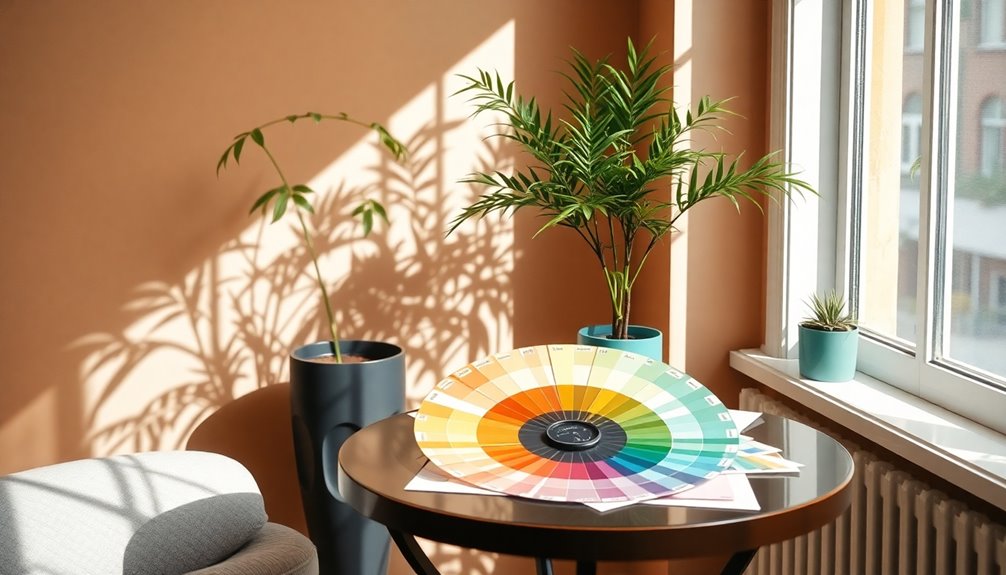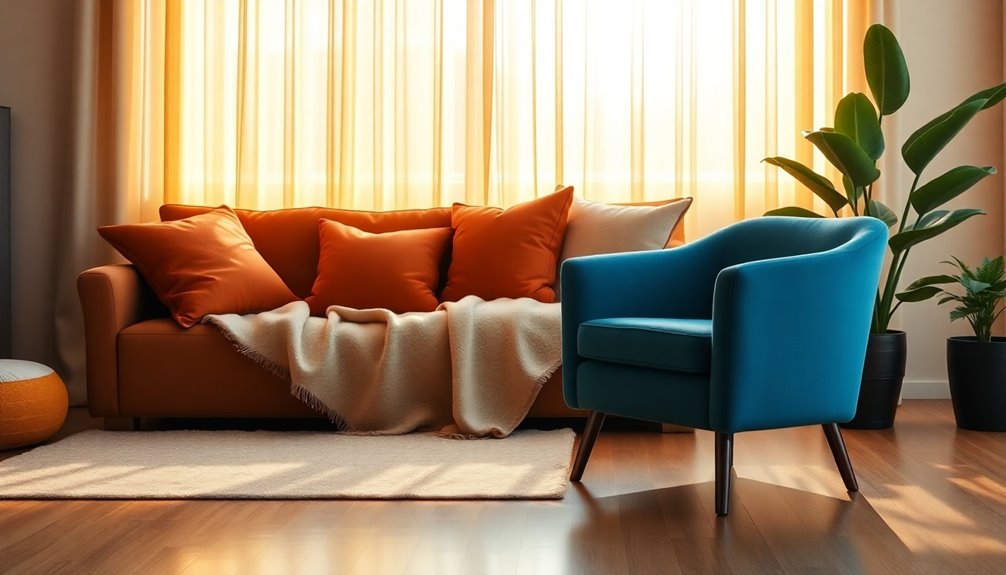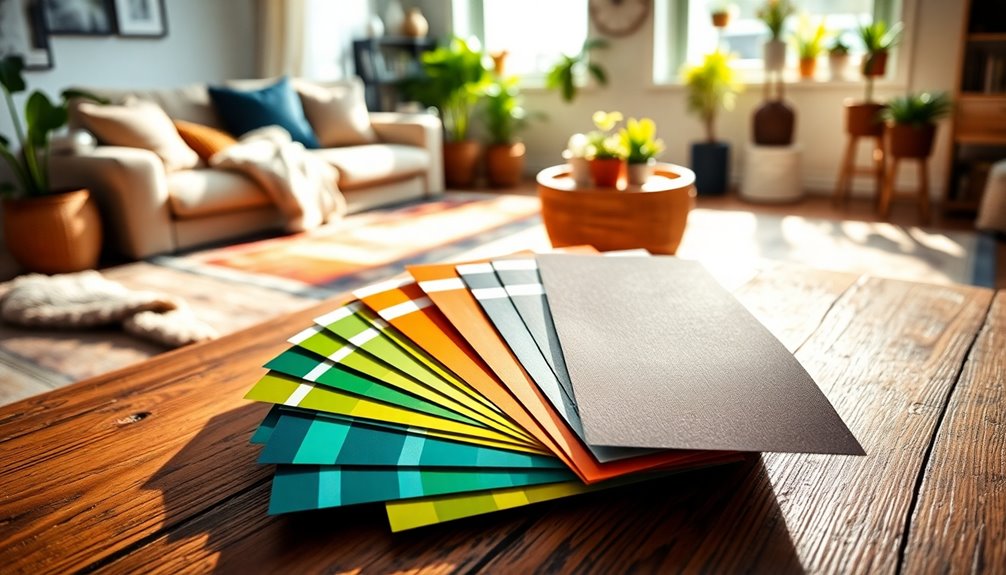To choose colors that complement your space, start with a favorite hue that resonates with you. Next, explore color relationships by combining complementary or analogous colors for balance. Don’t forget to mix warm and cool tones for added depth; think energizing reds with calming blues. Incorporate accent colors sparingly — around 10% of your palette — using them in textiles or decor. Finally, assess how natural and artificial lighting impacts your choices, as it can dramatically change your color’s appearance. There’s much more to uncover to perfect your palette. When finding the perfect hue, consider the mood you want to create in the space. Soft, muted tones can create a calming atmosphere, while bold, vibrant colors can add energy and personality. Experiment with different shades and tones to see how they interact with the lighting in your space. By taking the time to find the perfect hue and consider all of these factors, you can create a color scheme that truly enhances your space.
Key Takeaways
- Start by selecting a favorite color that evokes the desired emotional response for your space.
- Explore color relationships, using complementary or analogous schemes to create visual interest and harmony.
- Balance warm and cool tones to achieve a dynamic yet cohesive atmosphere throughout the space.
- Incorporate accent colors in moderation to enhance the overall color palette without overwhelming the design.
- Assess how natural and artificial lighting affects color perception to ensure your choices look great in all conditions.
Start With a Favorite Color

When choosing colors for your space, start with a favorite color that resonates with you. This color will serve as the foundation for your color palette, creating a sense of comfort and connection in your environment.
Think about the psychological effects of your chosen hue; for instance, if you love blue, it can promote calmness, making your space feel serene and inviting.
It's wise to select timeless shades rather than trendy colors, ensuring your design choices age gracefully. You want your favorite color to guide you as you explore various shades and tints, allowing for a rich and dynamic palette that maintains cohesiveness throughout your space.
Next, incorporate complementary colors that enhance your favorite hue. For example, if your favorite color is green, consider adding soft pinks or warm yellows to create a balanced atmosphere.
This thoughtful combination will help you achieve an inviting environment that feels both harmonious and visually appealing. Moreover, using a soft color palette can promote tranquility in your space, enhancing the overall ambiance.
Incorporating your favorite color along with complementary colors won't only elevate your design but also reflect your personal style, making your space uniquely yours.
Explore Color Relationships

Color relationships form the backbone of effective interior design, shaping how your space feels and looks. Understanding these relationships allows you to create stunning color combinations that enhance your environment. Here are three key types to explore:
- Complementary Color Scheme: This involves using colors directly opposite each other on the color wheel, like blue and orange. This creates a high contrast that energizes your space.
- Analogous Colors: These are colors next to each other on the wheel, such as yellow, yellow-green, and green. Utilizing these creates harmony, making your space feel cohesive and soothing.
- Tints and Shades: Mixing colors with white or black can add depth to your color palette. By incorporating various tints and shades within a color family, you maintain harmony while introducing visual interest.
Utilizing tools like color palette generators can help you identify and experiment with these color relationships.
By understanding and applying these fundamentals, you'll craft a space that reflects your personal style and evokes the desired emotional response.
Embrace the power of color relationships to transform your interior design effectively.
Balance Warm and Cool Tones

Creating a well-balanced color palette involves more than just choosing complementary hues; it also requires an awareness of warm and cool tones. Warm tones like reds, oranges, and yellows energize a space, while cool tones such as blues, greens, and purples promote calmness. By integrating both tone types, you can create a more inviting atmosphere.
For example, pair a vibrant terracotta—a warm color—with a soft teal—a cool counterpart—to achieve harmonious contrast. Incorporating natural materials like wood can also enhance the warmth of your color palette, providing a rustic feel that is essential in farmhouse aesthetics.
When balancing warm and cool tones, aim for an overall equilibrium, guaranteeing neither color overwhelms the room. If you have a mainly cool-toned space, consider adding warm wood accents to soften the look.
Natural lighting plays an essential role too; in bright light, warm tones can feel too intense, while cool tones may seem cold in dim conditions. Additionally, using ambient lighting solutions can enhance the overall ambiance and color perception in your space.
Using a neutral base can effectively bridge the gap between warm and cool tones, creating a cohesive color scheme. This neutral backdrop allows your accent colors to shine without overwhelming the overall design.
Incorporate Accent Colors

Accent colors serve as the dynamic punctuation in your color palette, adding vibrancy and personality to your space. To effectively incorporate accent colors, follow these guidelines:
- Proportion: Aim for accent colors to make up about 10% of your overall color scheme. This way, they'll provide a pop of interest without overwhelming your main hues.
- Cohesion: When selecting accent colors, consider using shades or tints of your dominant colors. This creates a cohesive look while adding visual depth to your complementary color palette.
- Personal Touch: Choose accent colors that reflect your style and interests. This personal touch not only enhances the character of your space but also guarantees that the colors complement the overall design theme.
You can incorporate accent colors through textiles, like cushions, rugs, or curtains. This approach allows you to easily change the aesthetic of your space without making permanent modifications.
Assess Lighting and Space

When planning your color scheme, analyzing the lighting and size of your space is fundamental. Natural light greatly influences how colors appear. In north-facing rooms, warmer tones can balance the cool light, while south-facing rooms can handle cooler colors due to abundant sunlight.
Pay attention to the type of artificial lighting, too—incandescent bulbs enhance warm tones, while fluorescent lights can create a cooler cast.
The size of your room also influences your color choices. Lighter colors help small spaces feel larger and more open, while darker shades can create a cozy, intimate atmosphere in larger areas.
Testing paint colors in various lighting conditions throughout the day is critical, as colors can shift dramatically from morning to evening with changing natural light.
Don't forget to take into account reflective surfaces like mirrors and glossy finishes. They can amplify light and affect how colors interact with each other, making it essential to account for these elements when selecting your palette.
Frequently Asked Questions
How Do You Choose Complementing Colors?
Did you know that 90% of people make snap judgments about a space based on color?
To choose complementing colors, start with a key color from your existing decor or a favorite item. Use the color wheel to find opposites for high contrast.
Limit your palette to 3 to 5 colors, mixing shades and tints for depth.
Always test your choices in different lighting to guarantee they work harmoniously together before finalizing.
What Is the 60 30 10 Rule?
The 60-30-10 rule is a simple guideline for balancing colors in your space.
You'll use 60% of a primary color for large areas like walls, 30% for a secondary color on smaller items like furniture, and 10% for an accent color that adds interest, such as decor or artwork.
This method helps create harmony and prevents any color from overwhelming the room, making your design visually appealing and cohesive.
What Is the Color Theory for Spaces?
Ever walked into a room and felt an unexpected wave of emotion? That's color theory at work! It's all about the relationships between hues.
Complementary colors sit opposite each other on the color wheel, creating vibrant contrasts. Warm tones energize, while cool shades calm.
You can also explore monochromatic schemes, which use variations of a single color for a cohesive look. Understanding these principles helps you create spaces that truly resonate with your feelings.
How Do You Decide What Colors Look Best on You?
To decide what colors look best on you, start by examining your skin undertone—warm undertones suit earthy tones, while cool undertones shine in jewel tones.
Experiment with color draping by holding different fabrics against your face to see which shades enhance your features.
Also, consider your hair color and the contrast between your features.
Online color analysis tools or consultations with stylists can help you create a personalized palette that flatters your unique appearance.









